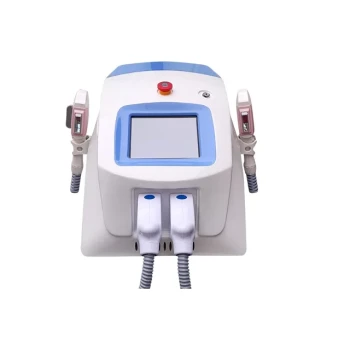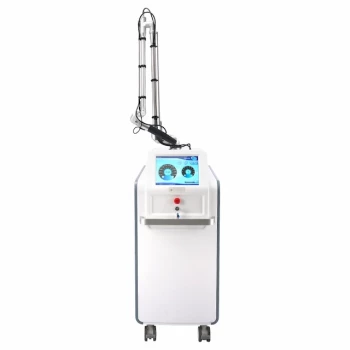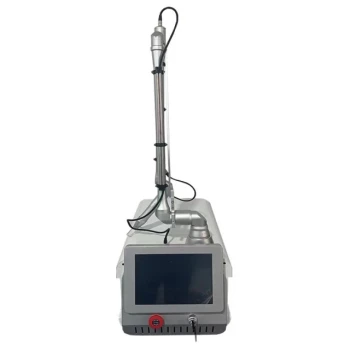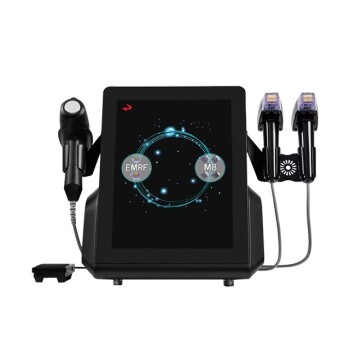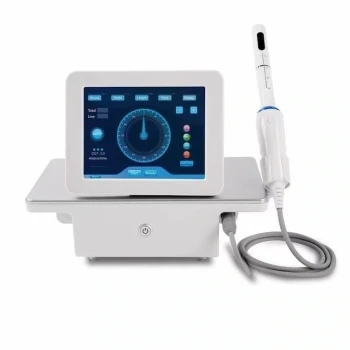In short, yes. SHR (Super Hair Removal) laser technology is widely regarded as one of the safest methods for permanent hair reduction. Its unique approach minimizes the risks commonly associated with older laser and IPL systems, particularly for individuals with darker or tanned skin.
The core reason for SHR's safety lies in its method: it uses low-energy, rapid-firing pulses to gradually heat the hair follicle. This is fundamentally different from traditional lasers that use a single, high-intensity pulse, significantly reducing the risk of burns, pain, and damage to the surrounding skin.
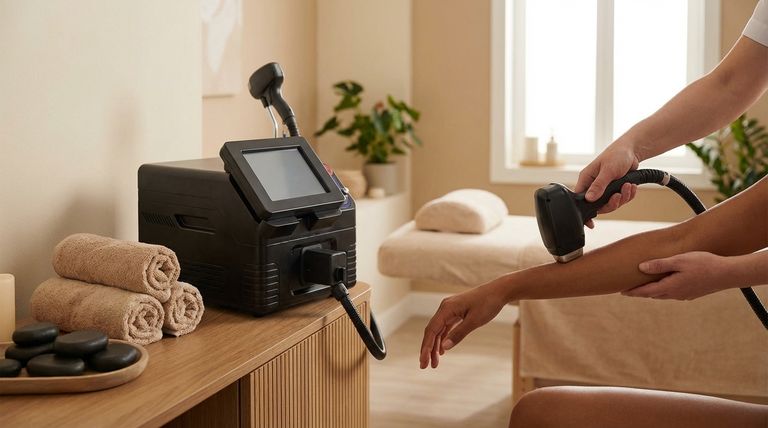
How SHR Technology Prioritizes Safety
To understand SHR's safety profile, it's crucial to distinguish it from older technologies. The innovation isn't just in the laser itself, but in how the energy is delivered to the skin and hair follicle.
The Principle of Gradual Heating
Traditional lasers operate on a high-intensity principle. They deliver a single, powerful blast of energy to destroy the hair follicle by targeting its melanin (pigment).
SHR technology uses a lower energy level (fluence) but delivers pulses at a much higher frequency. This "in-motion" technique involves moving the applicator repeatedly over the treatment area.
The effect is a gradual accumulation of heat in the deeper layers of the skin where the follicles reside, effectively disabling them without the intense thermal shock to the surface.
Protecting the Epidermis
The primary risk in any laser hair removal is damaging the epidermis (the outer layer of skin). This is where SHR's low-energy approach shines.
By not relying on a single, high-peak energy pulse, SHR keeps the surface of the skin cooler. This, combined with integrated contact cooling systems on the applicator, actively protects the epidermis from burns and pigmentation changes.
Safety Across All Skin Types
A major limitation of older laser systems was their inability to safely treat darker skin tones. SHR was specifically engineered to overcome this critical safety barrier.
The Challenge of Darker Skin
Traditional lasers can't easily differentiate between the melanin in a hair follicle and the melanin in dark skin. Applying high energy to dark skin could lead to burns, blistering, or hyperpigmentation.
SHR's Advantage for All Tones
SHR delivers energy that targets the follicle's stem cells as well as its melanin. Because the energy is lower and delivered gradually, it doesn't cause the same aggressive thermal reaction in the skin's pigment.
This is why, as confirmed by clinical approval, SHR is considered safe for all Fitzpatrick skin types (I-VI), from the very lightest to the very darkest. It can even be used safely on tanned skin, which is a significant risk factor for traditional laser treatments.
Understanding the Potential Side Effects
While SHR is exceptionally safe, no energy-based treatment is entirely without potential side effects. The key is that these effects are typically minor, predictable, and temporary.
Common and Mild Reactions
The most common side effects are mild redness and some slight swelling around the hair follicles, similar to a light sunburn. This feeling of warmth typically subsides within a few hours.
The Operator's Critical Role
The safety of any laser treatment is dependent on two factors: the quality of the device and the skill of the operator.
An inexperienced technician can still cause harm, even with the safest technology. It is essential to ensure your treatment is performed by a certified and experienced professional who conducts a thorough consultation and patch test.
Making the Right Choice for Your Goal
When considering SHR, your decision should be based on an understanding of both the technology and the provider.
- If your primary focus is safety on dark or tanned skin: SHR is one of the most reliable and proven technologies available, specifically designed to minimize risks for you.
- If your primary focus is comfort: SHR is often described as feeling like a "hot stone massage" and is significantly more comfortable than the "rubber band snap" sensation of traditional lasers.
- If your primary focus is achieving the best results safely: The skill of your technician is just as important as the machine; always choose a reputable clinic with certified providers.
By prioritizing a gradual and controlled approach, SHR technology empowers you to achieve effective hair removal without compromising the health of your skin.
Summary Table:
| Feature | Benefit |
|---|---|
| Gradual Heating | Reduces risk of burns and protects the epidermis |
| Low-Energy Pulses | Enhances comfort and safety for all skin tones |
| Suitable for All Skin Types | Safe for Fitzpatrick skin types I-VI, including tanned skin |
| Common Side Effects | Mild, temporary redness or swelling |
Ready to offer your clients the safest and most effective hair removal experience?
BELIS specializes in professional medical aesthetic equipment, including advanced SHR laser systems designed for medical aesthetics clinics and premium beauty salons. Our technology ensures superior results while prioritizing client safety and comfort.
Contact our experts today to learn how our SHR solutions can enhance your service offerings and build client trust.
Visual Guide
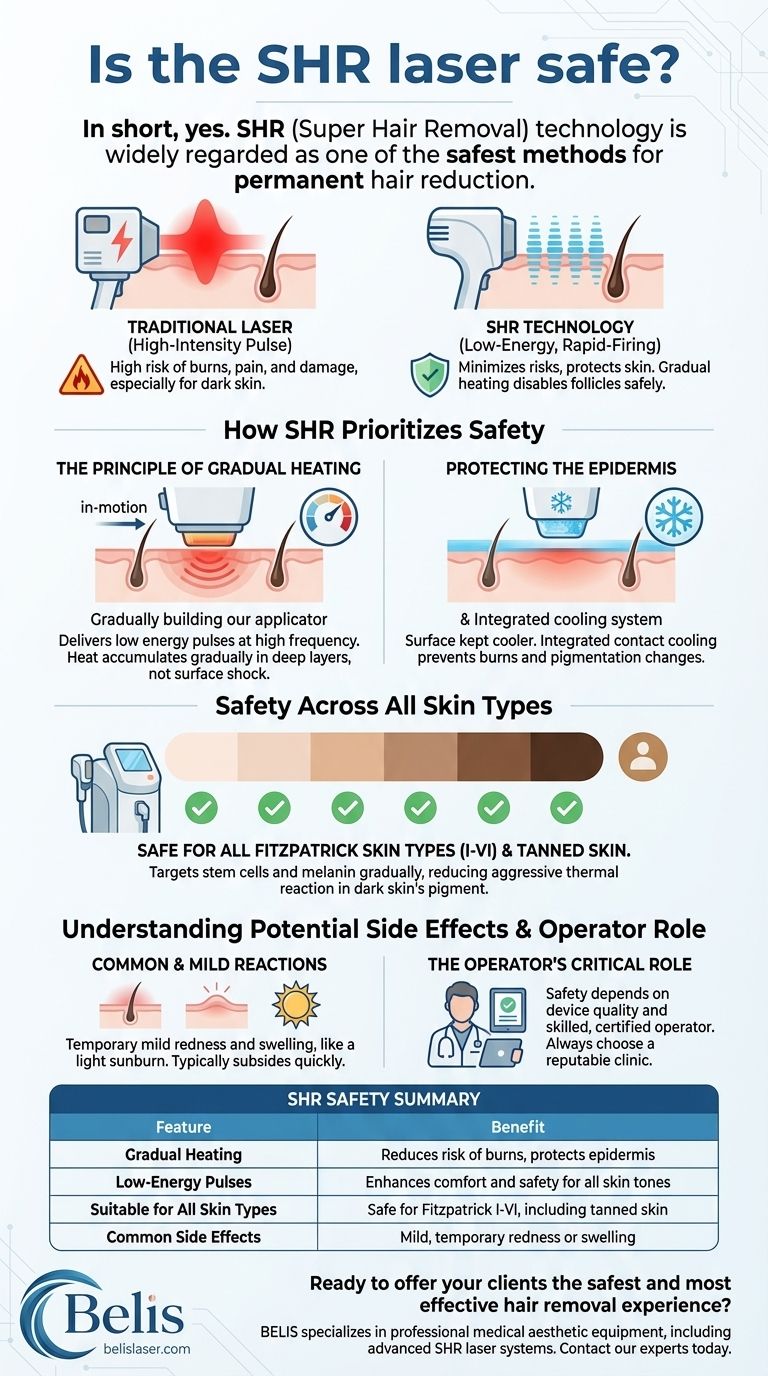
Related Products
- Diode Laser SHR Trilaser Hair Removal Machine for Clinic Use
- Trilaser Diode Hair Removal Machine for Beauty Clinic Use
- Clinic Diode Laser Hair Removal Machine with SHR and Trilaser Technology
- Diode Tri Laser Hair Removal Machine for Clinic Use
- Clinic Use IPL and SHR Hair Removal Machine with Nd Yag Laser Tattoo Removal
People Also Ask
- What skin type is diode laser for? Safe Hair Removal for Light to Dark Skin
- Can diode laser permanently remove hair? Achieve Lasting Hair Reduction with Professional Treatment
- How effective is diode laser hair removal? Achieve Long-Term Hair Reduction Safely
- How does diode laser hair removal work? The Science of Targeting Hair Follicles
- What are the disadvantages of diode laser hair removal? Key Limitations & Safety Risks Explained








